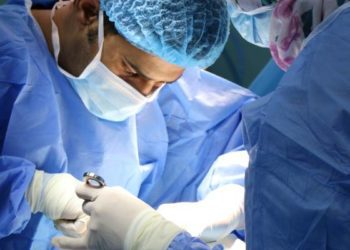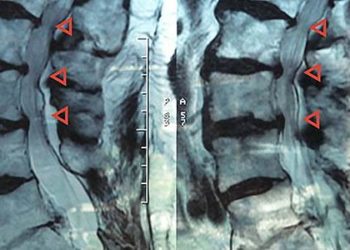Similar outcomes between physical therapy and surgery for lumbar spinal stenosis
1. After 2 years of follow-up, lumbar spinal stenosis treated with physical therapy and surgical decompression resulted in similar mean physical function scores.
Evidence Rating Level: 1 (Excellent)
Study Rundown: Lumbar spinal stenosis (LSS) involves the narrowing of the spinal canal and can cause pain and weakness in the lower back and thighs. Although surgery is an option in symptomatic LSS, the efficacy of physical therapy (PT) is unclear. In this study, LSS patients were randomized to two treatment groups, receiving ether surgical lumbar decompression or twice-weekly PT for 6 weeks. In an effort to minimize crossover, participants were eligible only if they were surgical candidates who consented to both randomization and to surgery prior to the study. Demographics were similar between groups and both reported an average of 7 of 10 pain at baseline. At the end of 2 years of follow-up, the primary endpoint physical function score improved similarly for the surgery and PT groups, and successful outcomes at follow-up were achieved in a majority of all patient groups. The major limitation of the study was the large number of crossovers between groups. However, this trial demonstrates that LSS surgical candidates who follow a structured PT regimen will likely obtain similar outcomes as surgery.
Click to read the study, published today in the Annals of Internal Medicine
Relevant Reading: Long-term Outcomes of Lumbar Spinal Stenosis: Eight-Year Results of the Spine Patient Outcomes Research Trial (SPORT)
In-Depth [randomized controlled trial]: In this study, 169 eligible patients with LSS were randomized, with 87 allocated to surgical decompression and 82 to PT. Forty-seven (57%) of PT subjects crossed over to surgery during the 2-year follow-up period with 66% occurring before week 10. Of the patients who crossed over, they tended to have more pain. In the PT group, 54 went to at least 50% of the 12 prescribed visits and the average attended was 8.4. Only two from the surgery group crossed over and both were in the first 10 weeks. At 2 years, the function score showed a mean change of 22.4 (95%CI 16.9-27.9) and 19.2 (95%CI 13.6-24.8) for surgery and PT, respectively. Intention to treat analysis showed no differences between groups (p > 0.50, adjusted mean difference 0.85). Successful outcomes were achieved by 45 (61%) of 74 surgery patients, 24 (55%) of 44 crossovers from PT to surgery and 15 (52%) of the 29 non-crossover PT patients. There was no difference in treatment effects over time between sexes (p = 0.066).
Image: CC/Philmarin
©2015 2 Minute Medicine, Inc. All rights reserved. No works may be reproduced without expressed written consent from 2 Minute Medicine, Inc. Inquire about licensing here. No article should be construed as medical advice and is not intended as such by the authors or by 2 Minute Medicine, Inc.






